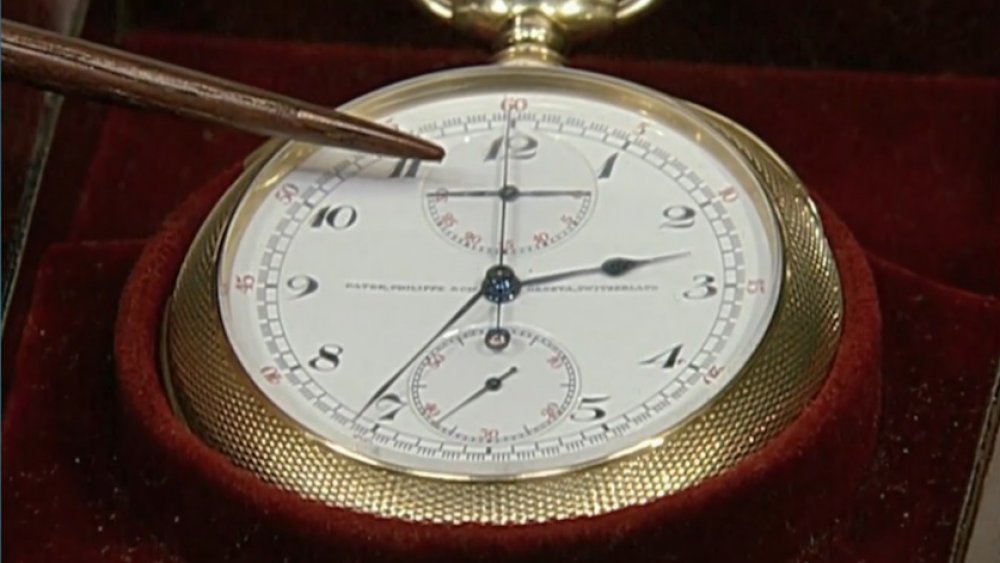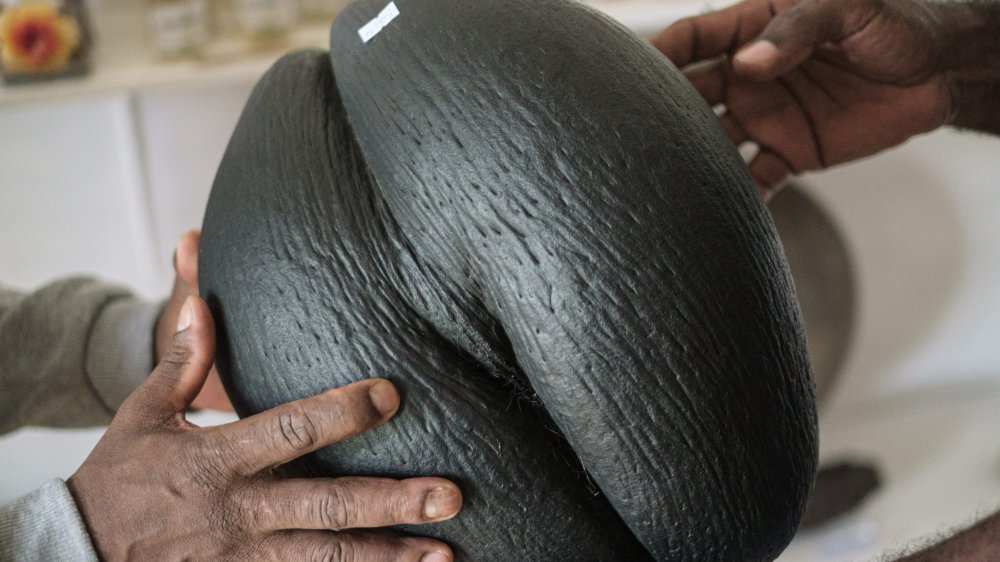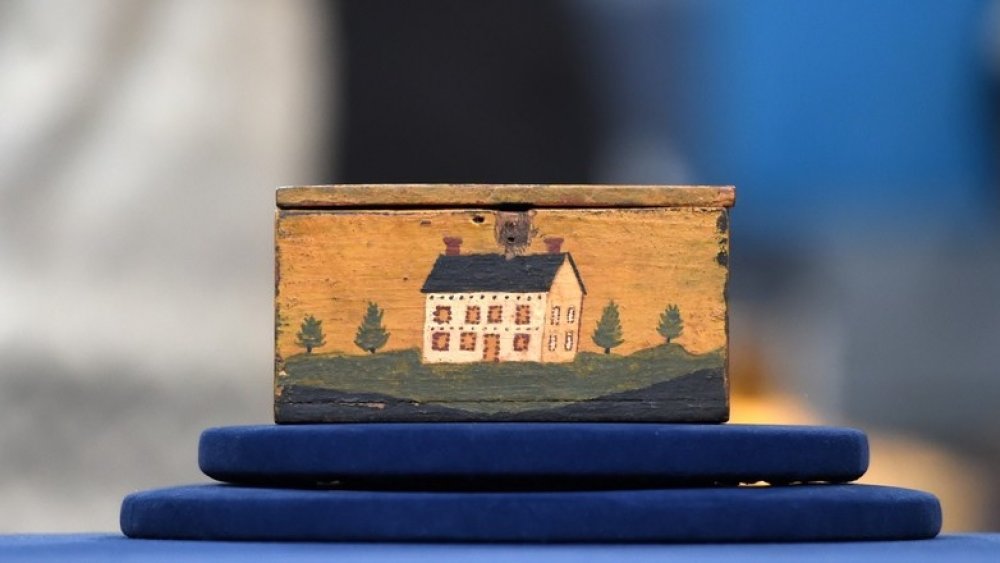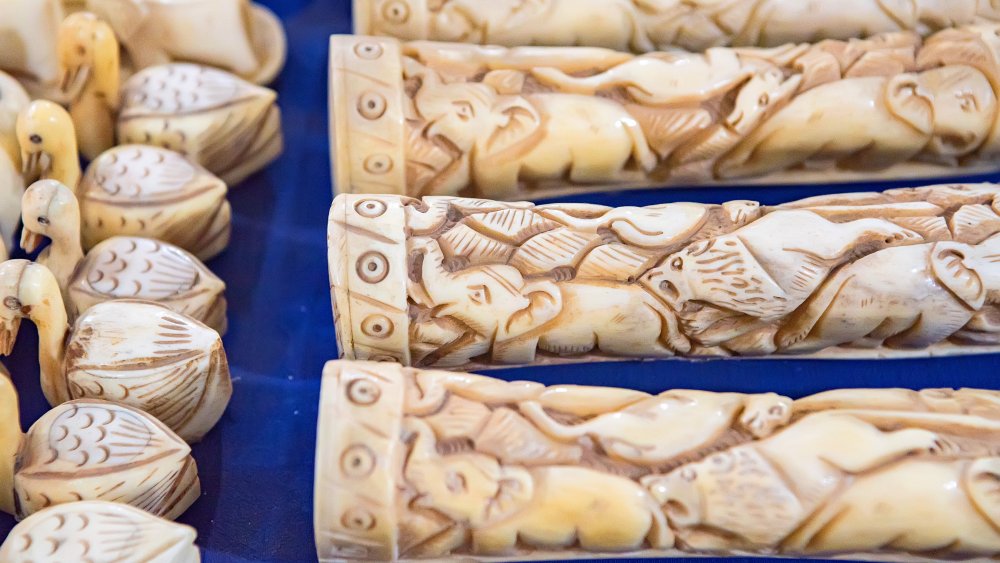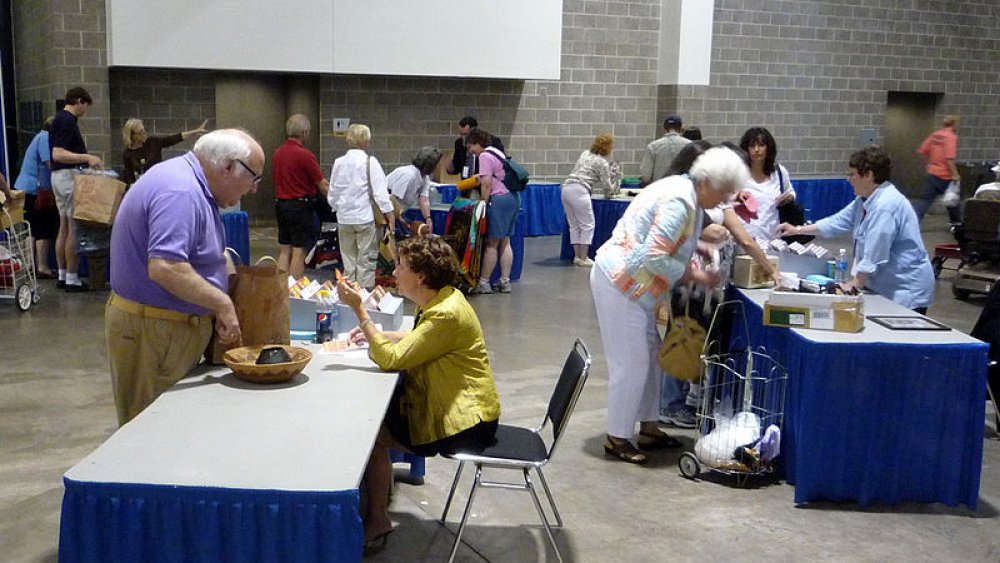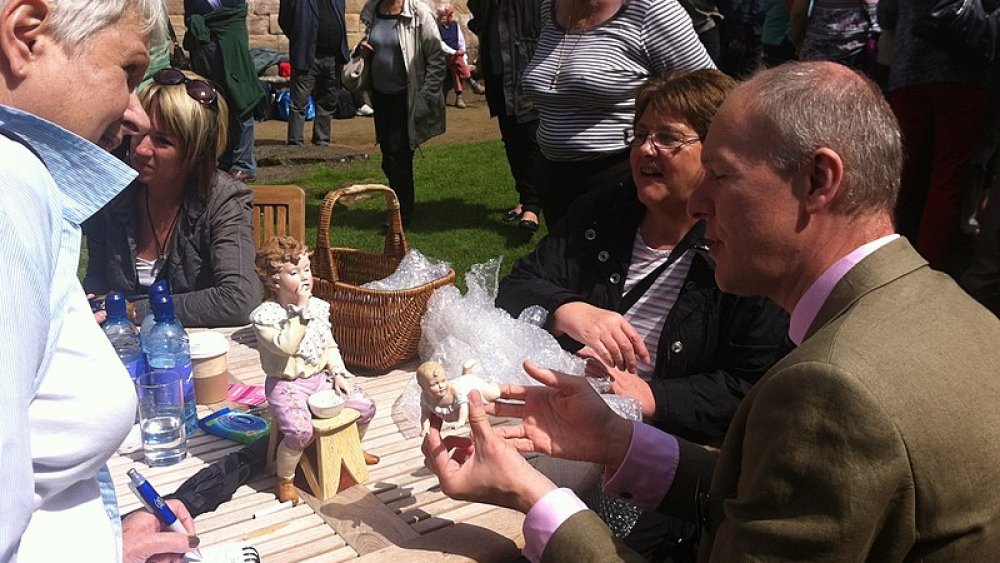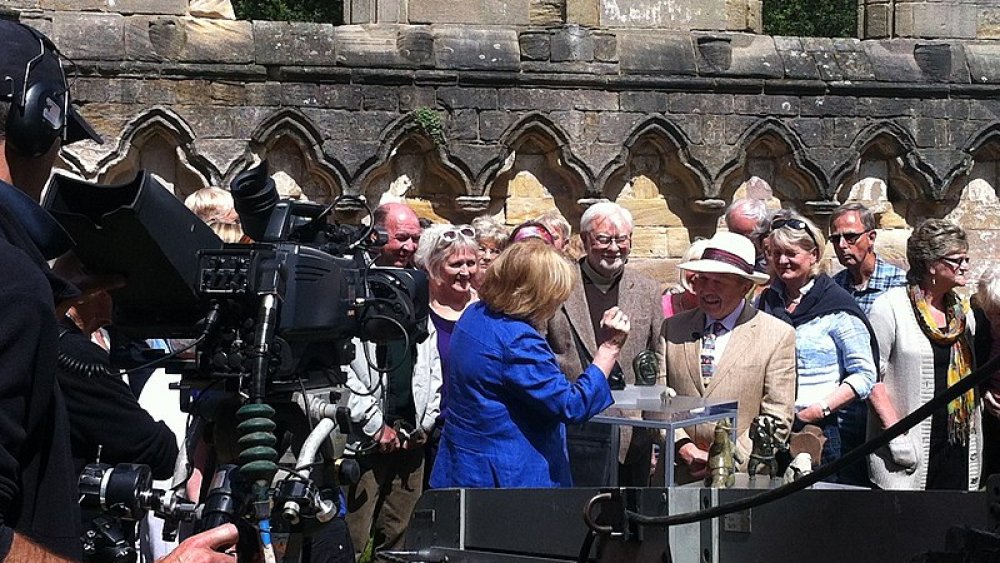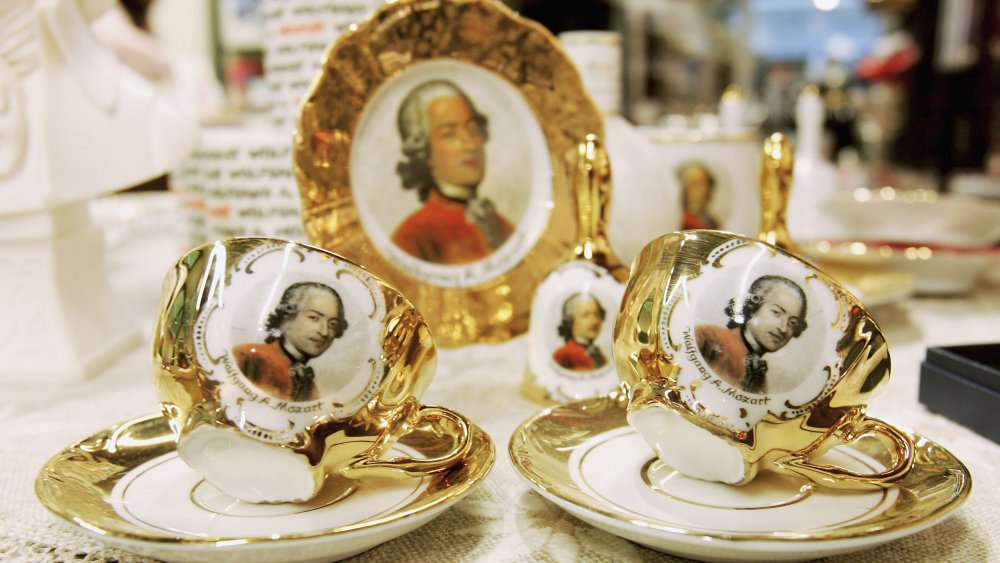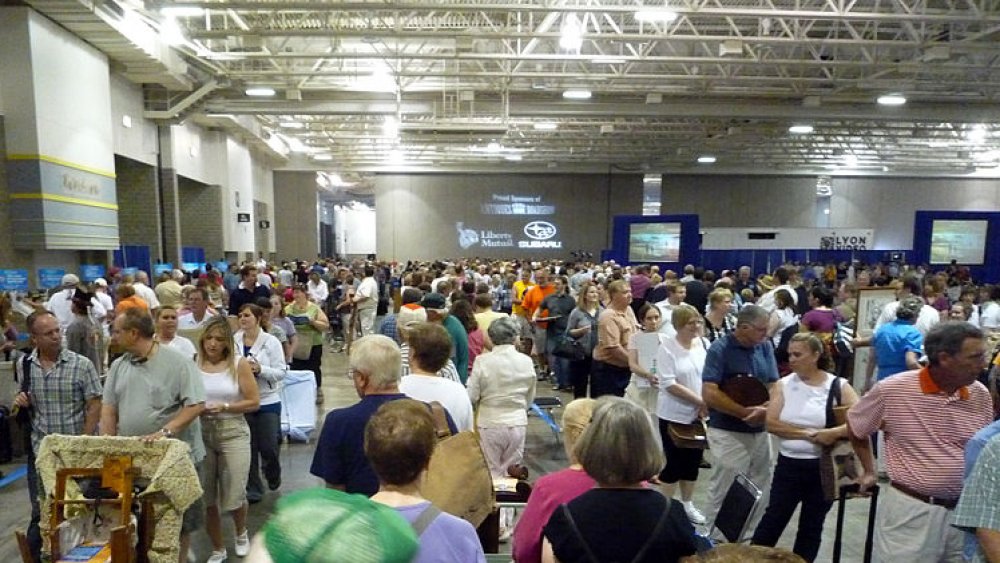The Untold Truth Of Antiques Roadshow
The popular television series Antiques Roadshow first premiered in the UK in 1979 before being adapted for American audiences in 1997. If nothing else, AR has made everyone ponder whether something you have is actually worth a fortune. Does that weird sculpture you've been using for a doorstop really date to the Ming Dynasty? Or that old painting of Grandma's, the one of a skinny child with big eyes: Is that actually an original painting rendered by renowned artist Margaret Keane? Indeed, nearly all of us have some unusual, antique goodie that makes us wonder if it is of any real value. The sky's the limit, from a simple ring in a jewelry box which turned out to have been owned by author Charlotte Bronte, to a 1974 Rolex watch which brought an appraisal between $500,000 and $700,000.
So say you have found that one thing, or maybe two things, which you think could really be worth something. Where to take it but on Antiques Roadshow, where experts will scope out your treasure and hopefully tell you all about its amazing past and that it's worth millions of dollars. But how do you get on the show? Do you buy tickets, or what? And is there any guarantee of getting an appraisal at all? And do those so-called experts really know what they're talking about? Here is the real scoop on the show, from how to get on to what happens once you're in the door.
What is the most expensive thing on Antiques Roadshow?
Antiques Roadshow's website explains that the vast majority of antiques on the show are usually valued at under $500. Still, there are those moments when something is actually worth more—quite a bit more. Love to Know reports that a guy in Tulsa, Oklahoma brought a collection of cups made from rhinoceros horns to the show in 2011. It turned out that the five cups had been carved in the 1700s and were once used as drinking cups, according to Screen Rant. The collection was valued at between a million and $1.5 million and remains one of the most valuable items ever seen on the show.
Then there was the man who, in 2004, brought a family heirloom to the show. Love to Know describes it as a Swiss Patek Philippe pocket watch (pictured). All the owner knew was that it belonged to his grandfather back in 1914 and had been passed down through the family. The neatest thing was that the watch came complete with the original box, warranty, and even spare parts, and was obviously well taken care of. The owner had also had it appraised and knew it was worth at least $6,000. Imagine his surprise when AR valued the watch at $250,000! But it gets even better: two years later the pocket watch sold at Sotheby's for $1,541,212. Today, according to Screen Rant, the same watch is worth between $2 million and $3 million.
How weird can Antiques Roadshow get?
Some strange stuff does occasionally appear on Antiques Roadshow: In March 2020, Metro reported on what looked like a large varnished nut on the show. The object brought a lot of comments, and laughs—mostly because it sort of resembled a big derriere. The nut was ultimately identified as a "coco de mer" (similar to the one pictured) from the Seychelles islands, which are located far off the east coast of Africa in the western Indian Ocean (per the official website). The nuts were originally believed to be from mythical trees below the ocean until their origins were finally identified in 1768, according to antiques expert Marc Allum. "It's hand finished as well," he noted, explaining the item was "essentially a huge sea pod. A sort of double coconut."
Another oddball piece was a simple Monopoly game, according to Radio Times. What made it unique was that after a group of thieves committed England's "Great Train Robbery" in 1963 (netting £2.3 million) the gang played the game, using real cash, at a hideout, reported British Transport Police. Authorities on the gang's trail found the game and were able to identify the robbers from their fingerprints on the board. Several men were convicted of the robbery, but the true mastermind of the operation was not revealed until 2014, according to Smithsonian Magazine. Radio Times reported appraiser George Archdale valued the Monopoly game at "just £100—£200, thinking it wrong for money to be made from a crime."
Are the experts really experts on Antiques Roadshow?
AR's so-called "experts" messed up following the very first season of the show in 1996, according to Live Auctioneers. Appraiser Russ Pritchard valued an antique sword at $35,000. The Boston Herald called foul, according to Love to Know, and producers discovered that Pritchard and alleged sword owner Stephen Sadtler were high school buddies and staged the appraisal. Stadtler did not even own the sword. The episode was pulled, but Pritchard and another cohort, George Juno, were contacted by descendants of Major Samuel J. Wilson who had seen the show. The men appraised Wilson's Civil War sword at nearly $8,000 and bought it for display in the National Civil War Museum in Pennsylvania. Instead, however, the men coordinated the sale of the sword for $20,000. Pritchard eventually went to jail.
These days, AR makes sure to keep an updated list of appraisers on their website. But there is always a chance that even a professional might make a mistake. Some years back, reports The Guardian, appraiser Stephen Fletcher identified an odd looking jug as "late 19th century," compared it to Pablo Picasso, and valued the item at between $30,000 and $50,000 — a friend of Betsy Soule contacted the show and confirmed that Soule made the jug in high school, circa 1973. Sometimes too, you may get the wrong appraiser, according to SpareFoot. One guest with some carved arrows landed with a military expert who obviously knew nothing about them and low-balled their worth.
Has anything fake ever been appraised on Antiques Roadshow?
Antique Roadshow's bonafide experts are usually good at spotting fakes, but a few get by them—such as a hand painted box by early Pennsylvania folk artist Jacob Weber. In 2016, the show's website confirmed that appraiser Wes Cowan incorrectly assessed the item as an authentic antique. Antique dealer Patrick Bell set the record straight, explaining that the box's hasp, hinges, wood bottom and paint indicating the trinket was probably a fake. AR corrected the error, reporting the outcome and admitting that "even so-called 'experts' can be fooled." Still, the antique box received an appraised value of between $100 to $150. Not bad for some early American folk art.
Fraudulent watches are especially prone to duping innocent buyers. On an episode on AR's British version, watch expert Richard Price says fake watches have increasingly been made harder to spot, and that "sophisticated fakes can test even experts." The trick is to check out the movements, where such tell-tale signs as peeling gold plating, fake "hallmarks" which mark the purity of the item and even the watch's weight can signify it isn't real. This is best checked by a specialist or professional jeweler.
Jewelry is another problem area, according to appraiser Joyce Jones (via Lifestyle). The market is ripe for rip-off replicas of such well-known brands as Coco Chanel, Christian Dior, and Elsa Schiaparelli especially. Even if you aren't going on AR, an ABC report quotes writer Bob Jackman as advising buyers to proceed with suspicion to avoid getting ripped off.
What is considered an illegal item at Antiques Roadshow?
Some items are forbidden to bring to Antiques Roadshow. Ivory is one of them, according to the show's site. It's not necessarily that it is illegal to own antique ivory in its various forms, but rather that our government almost completely banned commercial trade in 2016 because the ivory trade continues to encourage poaching. The 2016 directive was actually a follow-up to the Endangered Species Act of 1973, which required permission from the Secretary of the Interior or the Secretary of Commerce "to engage in business... as an importer or exporter of any amount of raw or worked African elephant ivory." And although ivory is commonly seen at many estates and yard sales, AR would rather not deal with its sensitive nature.
Another touchy area is Native American artifacts. Antiques Roadshow explains that laws governing ownership of such things "make a complicated field." In 2013, a woman brought an Anasazi pot to the show, which was valued between $3,000 and $4,000. But the item raised the question as to whether it was legal for the lady to own it. In 1990, according to the National Park Service, the Native American Graves Protection and Repatriation Act made it illegal to collect Native artifacts. But that has not stopped people from doing it anyway: in 2018, the Bowling Green Daily News in Kentucky reported that resident Gary Womack was sentenced to 15 months in prison for "illegally acquiring and trading prehistoric artifacts."
How do I get something appraised on Antiques Roadshow?
Every person lucky enough to get into an Antiques Roadshow event is guaranteed a free appraisal. But, there is no guarantee you will actually appear on the show. The reason, according to Reality Blurred, is that at an average of 2,500 attendees with two items per show, upwards of 5,000 objects could possibly be appraised. The key to actually scoring an on-camera appraisal, advises the Cheat Sheet, is to bring something truly unique, with a great story behind it. Even something with a high appraisal might be passed up for something else with an intriguing history and provenance.
Here is how it works: appraisers view each item at the event and alert producers if it something show-worthy. Then, according to Collectors Weekly, you wait in a line and eventually will be sorted into other lines, depending on what category your particular item falls into. After more waiting, the staff will eventually shuffle you onto the set and into another line to meet with an appraiser. If the appraiser thinks your item is special enough, they tell a producer, who then decides whether to air the appraisal. Bear in mind, if you get this far and the item is a hit, be sure to act very, very surprised. Otherwise the segment is less likely to air. On a side note, if you're watching from home, taking a sip of your cocktail each time a guest utters "Wow!" makes for a great drinking game.
Are the appraised values on Antiques Roadshow for real?
Not necessarily. No appraisal is official, since those in the business actually use three methods to assess the value of an item: auction, retail and insurance. AR's website explains that the auction value is basically set by the buyer, although someone vying for a highly desirable item might bid far more than the item's retail value. "This is why the most valuable items are often sold at auction," says appraiser and auctioneer Kerry Shrives. "It's often the best way to realize maximum value for a rare object." On the retail side of things, dealers pay less than an item's worth in order to make money when they sell it—and that can result in setting the price higher for a bigger profit. That leads to the insured value, which insurance companies set at "at the top end of retail value," just enough for the owner to buy a replacement.
Indeed, any appraisal on AR is basically approximate, although the appraisers do have time to research the item at hand using computers, libraries, sales comparisons, and what is known about the item's history. If the item is a really big deal, according to The Magnusson Group, the producers and appraisers likely know about your goodie before you even bring it to the show. And, collector Duane Dimock (via the San Diego Reader) surmises that since appraisers are not paid, giving accurate values can give them needed exposure to draw more business.
What happens if it turns out my item is really valuable?
Ever dream of hitting the lottery in a crowded place and realizing you haven't signed your ticket? Talk about feeling like a target and squirming in your seat! But just imagine hitting the proverbial lottery with your valuable item at Antiques Roadshow, with thousands of strangers and cameras around you. Country Living verifies that the show does keep security guards around for guests whose goods are worth a bit, and police are on hand to escort those with high-dollar items to their car. And, the official rules assure attendees that AR "provides private security and police at all times at production events. All guests entering the event are subject to search and Antiques Roadshow may deny entry to anyone for any reason."
But securing the area goes much further than just hiring local guards and notifying police. In her 2009 book, Antiques Roadshow Behind the Scenes: An Insider's Guide to PBS's #1 Weekly Show, author Marsha Bemko wrote about security director Sean Quinn, who personally visited each town ahead of the show to "make recommendations regarding our security plan." And, volunteers working for AR are trained, and cautioned to call a supervisor and security should they see something amiss—such as guns without the required white tag on them which is affixed by police officers as guests enter the show. In addition, Quinn said, two paramedics are also on hand in case someone suffers from a medical emergency.
How many items can you bring to Antiques Roadshow?
Attendees are limited to two items per ticket, but they can be a collection consisting of several items, according to the Antiques Roadshow website. Even so, the items should be as closely related as possible (i.e. a set of teacups versus a large gathering of mismatched jewelry items which must be assessed separately). There are, however, certain items that AR will not appraise. These include ammunition or explosives, bicycles, cars, coins, fossils, paper currency, stamps, or stock certificates. In the interest of safety, antique glass fire extinguishers are prohibited too. Antique Trader explains that these round glass collectibles were filled with either salt water or a chemical, carbon tetrachloride, the latter of which can be dangerous if the fragile bulb is broken.
Notably, weapons are also prohibited under certain circumstances. According to My Arkansas PBS, all knives and swords must be in a sheath or wrapped to prevent injury. All firearms have to be unloaded. And even if it is an antique, bringing a gun is still subject to laws in the town, county or state where Antiques Roadshow is holding the event. Furthermore, both law enforcement and appraisers must confirm that the firearm is safe, and you must have it checked before entering the show. Trigger locks are recommended but not required, although staff will install one if they deem it necessary. It is also important to remember that anyone entering the area can be searched if they appear suspicious.
So how do I get on Antiques Roadshow?
It isn't easy to get on Antiques Roadshow, although there are four ways to score tickets, according to the show's website. One of them is a "sweepstakes," wherein entrants access the site with a valid email address and fill out an electronic form in its entirety (those in Canada must also "correctly answer the question about Antiques Roadshow that appears on the entry form.") A second sweepstakes requires participants to follow AR on Twitter or Instagram with their own account and type in a comment "by tagging a friend and including the city of the appraisal event they wish to attend."
Then there is the "Knock Our Socks Off!" Contest. In this, entrants have to submit an online entry form at a different site. The submission must include your description of the item you are bringing in 20 words or less and your story about the item in 200 words or less. You also have to submit at least one photo of the item, and it has to comply with specific upload criteria. And, your item must fit into a category on a drop-down list. Last is the Furniture Contest, wherein those wanting to lug their antique rocker or whatever must enter the first Sweepstakes contest, live within 60 miles of the event, submit an entry form, include a photo, and agree to let AR staff transport the item to and from the event and use it on the show.
Does anything get sold from being on Antiques Roadshow?
So say you actually get a ticket to get on the show and your antique proves to be valuable, and you want to sell it. Now what? Well, You are not allowed to buy and sell items or do business with appraisers at the show, according to the rules. If you do want to do business with an AR appraiser at a later date, the producers recommend checking their references, getting a second opinion, looking at your selling options (auction versus retail), consulting a lawyer if a contract is negotiated, and getting a detailed, written receipt from the buyer or consignee. And, be sure you know what will happen if your item does not sell at the price you negotiate.
Also, be aware that the appraised value does not always mean your item will sell for that amount. Love to Know has several recommendations for online appraisals, cautioning those who do so that the valuation is "not usually very accurate," and also, just like on Antiques Roadshow, "the value is only what people are willing to pay for it at that time." If you think an in-person appraisal might be better, find a local auction house that might offer a free appraisal day. Antique shows are an option too, as well as other "appraisal shows" similar to Antiques Roadshow—like Dr. Lori's, which hosts over 150 shows annually. The admission charge includes one free appraisal, and additional appraisals cost $25.00.

